| Columns Retired Columns & Blogs |
Measurements that askew could indicate something happened during shipping. Zesto should send another amp to be measured.
Sidebar 3: Measurements
I performed the measurements of the Zesto Bia 200 Select with my Audio Precision SYS2722 system. Following the instructions in the comprehensive manual, I carefully installed the small-signal tubes and the KT150 output tubes, the latter supplied as standard. With three auto bias settings for the KT150s, three output transformer taps—labeled 4 ohms, 8 ohms, and 16 ohms—and both single-ended and balanced inputs, this is a complicated amplifier. I performed a complete set of tests with the KT150s, using the single-ended inputs, all three bias settings, and all three output transformer taps.
The Bia 200 runs hot. After the amplifier had been powered up for an hour, the temperature of the right-hand side of the top panel was 110.5°F/43.6°C.
The Zesto's single-ended input impedance is specified as 47k ohms. I measured 11k ohms at 20Hz–20kHz. The balanced input impedance is specified as 10k ohms. I measured 11k ohms at 20Hz and 20kHz and 12k ohms at 1kHz. The Bia 200 preserved absolute polarity, ie, was noninverting, with both types of inputs and from all the output transformer taps.
The amplifier's voltage gain depended on the input type, the output tap, and, to a small extent, the bias setting. With the single-ended inputs and high bias, the gain at 1kHz into 8 ohms was a moderately low 25.8dB from the 16 ohm tap, 26dB from the 8 ohm tap, and 25.2dB from the 4 ohm tap. The medium-bias setting reduced these gains by 0.5dB; the low bias setting lowered the gains by another 0.5dB. The gain from the balanced inputs was the same with all taps and bias settings.
With the high bias setting, the source impedance from the 16 ohm output tap was a very high 11.5 ohms at 20Hz, 13.6 ohms at 1kHz, and 11.3 ohms at 20kHz. The impedance from the 8 ohm output tap was 6 ohms at 20Hz and 1kHz, increasing slightly to 6.85 ohms at 20kHz. From the 4 ohm tap, the impedance was 3.2 ohms at 20Hz and 3.7 ohms at 1kHz and 20kHz. The medium-bias setting increased these impedances by 2 ohms from the 16 ohm and 8 ohm taps and by 0.5 ohms from the 4 ohm tap. The low bias setting added another 2 ohms, 1 ohm, and 0.5 ohm, respectively.
These are all very high output impedance values. The Bia 200 seems to conform to classic telecommunications practice in which matching the source impedance to the load impedance—making them the same—maximizes power transfer to the load. This works well when the load impedance doesn't vary with frequency. However, with loudspeakers, where the impedance can have very different magnitudes at different frequencies, a high source impedance interacts with the loudspeaker impedance, modulating the frequency response. The gray trace in fig.1, for example, shows the variation in the small-signal frequency response with the 16 ohm output tap with our standard simulated loudspeaker load: a very audible ±4dB. The variation was lower from the 8 ohm tap, at ±3dB, and from the 4 ohm tap, at ±2dB (fig.2), but these variations will still be audible, and they'll vary from loudspeaker to loudspeaker.


Into resistive loads (figs.1 & 2, blue, red, cyan, magenta, and green traces), the right channel's output (red and magenta traces) was about 0.25dB higher than the left channel's (blue and cyan traces). Of greater concern was the fact that the left channel rolled off earlier at high frequencies, reaching –2dB at 20kHz into 8 ohms compared with the right channel's –2dB at 48kHz; from the 8 ohm tap at 10kHz, the interchannel difference is a potentially audible 0.7dB.

Fig.3 shows the waveform of a small-signal 10kHz squarewave as reproduced by the left channel. The risetimes are lengthened, though commendably, no overshoot or ringing is present. The frequency response was not affected by the bias setting.
The Zesto's channel separation (not shown) was good, at >70dB in both directions below 3kHz and still 60dB at the top of the audioband. The unweighted, wideband signal/noise ratio (ref. 1W into 8 ohms), taken from the 4 ohm taps with the unbalanced inputs shorted to ground, was a good 72dB in the left channel but 59.2dB in the right channel. These ratios improved slightly when the measurement bandwidth was restricted to 22Hz–22kHz, and to 83.2dB, left, and 72.4dB, right, when A-weighted.
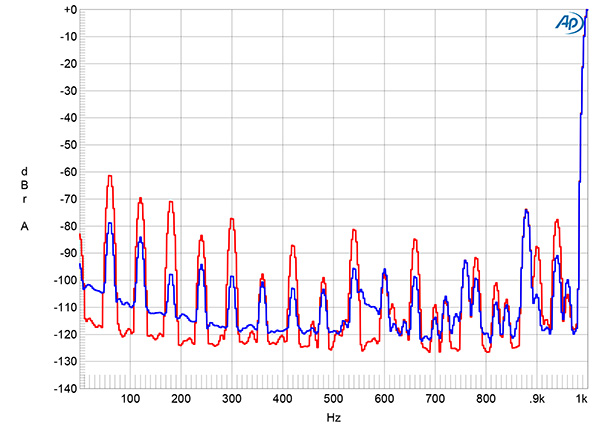
Spectral analysis of the low-frequency noisefloor with the Zesto's 4 ohm taps driving a 1kHz tone at 1Wpc into 8 ohms (fig.4) revealed a low level of random noise in both channels. AC supply–related spuriae at 60Hz and its odd- and even-order harmonics were much higher in the right channel (red trace) than the left (blue trace); the highest-level harmonic (the 2nd) lay at –62dB. The levels of these power supply–related spuriae didn't change when I experimented with the signal grounding between the amplifier and the Audio Precision analyzer or when I repeated the test with a cheater plug lifting the AC supply ground. (The amplifier's manual strongly warns against operating the amplifier with a cheater plug, but I needed to see if it made a difference.)
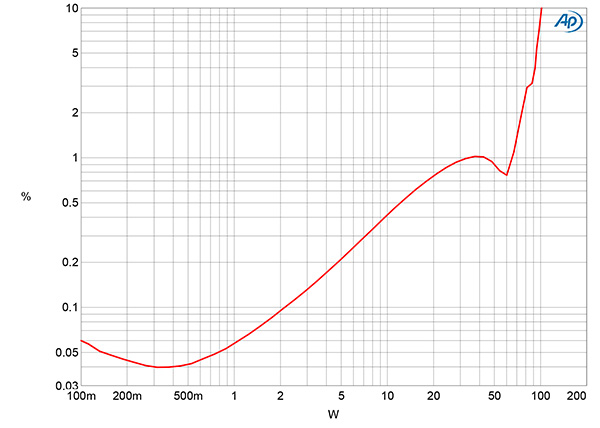


The Bia 200's maximum power with KT150 output tubes is specified as 100Wpc (20dBW) with high bias, 85Wpc (19.3dBW) with medium bias, and 60Wpc (17.8dBW) with low bias; no load impedance or distortion percentage is mentioned. Looking first at the high-bias setting: With our usual definition of clipping—when the THD+noise reaches 1%—and with both channels driven, I measured a clipping power of 36Wpc from the 8 ohm tap into 8 ohms (15.6dBW, fig.5) and 28Wpc from the 4 ohm tap into 4 ohms (11.5dBW, fig.6). At 3% THD+N, I measured 85Wpc with each output tap matched to the load, and at 10%, the specified 100Wpc from the 8 ohm tap and 94.5Wpc from the 4 ohm tap (16.75dBW), again with the taps matched to the loads. Less power was available from the 8 ohm tap into 4 ohms and from the 4 ohm tap driving 8 ohms (fig.7): 17.6Wpc at 1% THD+N (12.5dBW), 56Wpc at 3% THD+N (17.5dBW), and 69Wpc at 10% THD+N (18.4dBW).
Setting the bias to the medium switch position gave maximum powers of 45Wpc at 3% THD+N (16.5dBW) and 78Wpc at 10% THD+N from the 8 ohm tap into 8 ohms (18.9dBW) and from the 4 ohm tap into 4 ohms (15.9dBW). With the Zesto's low bias setting, I measured 28Wpc at 3% THD+N (14.5dBW) and 42Wpc at 10% THD+N (16.2dBW) with the output tap matched to the load. The shape of the traces in figs.5–7 suggests that a relatively limited amount of loop negative feedback has been employed (footnote 1). Watching the traces on the oscilloscope screen as I performed these tests, I observed that the amplifier's output waveform started to triangulate before the tops and bottoms became squared off.
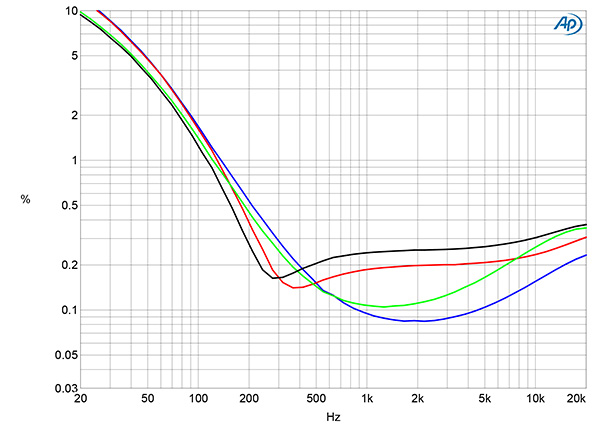
Figs.5–7 show that distortion is relatively low at low powers. Fig.8 shows how the percentage of THD+N in both channels varied with frequency with the 4 ohm transformer tap driving 8 and 4 ohms at 2.83V. (The manual specifies the THD as approximately 0.22% at 1W into 8 ohms, but without the frequency being mentioned.) At high frequencies, the THD+N was lowest in the left channel (green and gray traces). However, the distortion rises significantly in the lower midrange and bass in both channels. Even at this relatively low voltage, which is equivalent to 1W into 8 ohms and 2W into 4 ohms, the distortion is >3% below 60Hz.


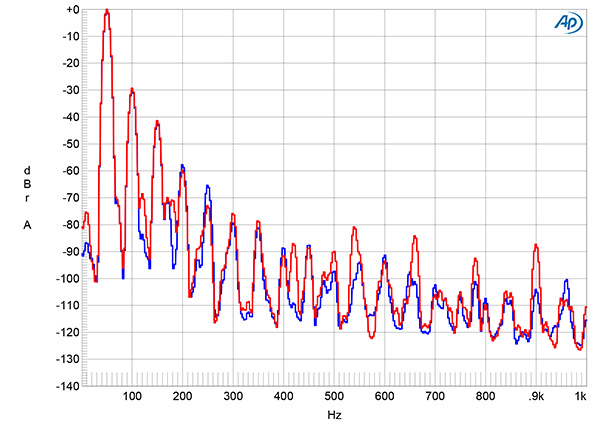

At 1kHz, the left channel's distortion waveform (fig.9) was predominantly the subjectively innocuous third harmonic, though the second harmonic was equally high in level in the right channel (fig.10). However, at low frequencies the second harmonic was the highest in level in both channels (fig.11), which suggests that the KT150 tubes are not well-matched. (In a push-pull circuit, having the active devices perfectly matched eliminates even-order distortion.) Fortunately, intermodulation distortion at high frequencies was relatively low in level. With the Bia 200's 8 ohm taps driving an equal mix of 19 and 20kHz tones at 5Wpc peak into 8 ohms (fig.12), the 1kHz difference product lay at –54dB (0.2%), with the higher-order products at 18 and 21kHz 10dB lower in level.
I then installed the KT88 tubes that KM had also used for his auditioning, making sure that the bias was set to the low position, as discussed in the manual, and repeated some of the tests using the unbalanced inputs.

The voltage gain into 8 ohms was slightly lower than it had been with KT150s, at 24.1dB from the 16 ohm tap, 24.9dB from the 8 ohm tap, and 24.8dB from the 4 ohm tap. This will be due to the output impedance from each tap being higher than it was with the KT150s. The 1kHz impedances were 21.85 ohms from the 16 ohm tap, 10.9 ohms from the 8 ohm tap, and 5.6 ohms from the 4 ohm tap. As a result, the variations in the amplifier's response from the 4 ohm tap with our standard simulated loudspeaker reached ±2.6dB (fig.13), with even larger variations from the 8 ohm and 16 ohm taps. As it had with the KT150 tubes, the left channel rolled off earlier at high frequencies than the right, which means that this issue might be due to an incorrect component value in the low-level circuitry.
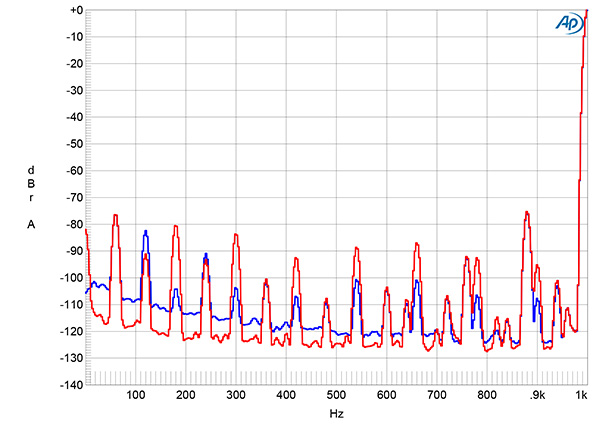
On the other hand, the signal/noise ratios with KT88s were better than they had been with KT150s. The unweighted, wideband signal/noise ratio (ref. 1W into 8 ohms), taken from the 4 ohm taps with the unbalanced inputs shorted to ground, was 73dB in the left channel and 70.4dB in the right channel. These ratios improved to 85.2dB, left, and 77.7dB, right, when A-weighted. Fig.14 shows the spectral analysis of the low-frequency noisefloor while the 4 ohm taps drove a 1kHz tone at 1Wpc into 8 ohms. If you compare this graph with fig.4, you can see that the 60Hz component is now at the same level, –77dB, in both channels, while it was 15dB higher than that in the right channel with KT150 tubes.

Although Zesto states that the maximum power with KT88s is 60Wpc (17.8dBW into 8 ohms), the amplifier didn't meet that specified power. With either the 8 ohm tap driving 8 ohms (fig.15) or the 4 ohm tap driving 4 ohms, the THD+N was 1% at 23.5Wpc, 3% at 28.5Wpc, and 10% at 42Wpc (16.2dBW, 8 ohms; 13.2dBW, 4 ohms).


However, when I plotted how the THD+N varied with frequency from the 4 ohm taps at the same voltage with which I had plotted fig.8, not only was the lowest distortion now obtained with an 8 ohm load (fig.16, blue and red traces), but the right channel's distortion (red and gray traces) was very much lower at low frequencies than it had been with KT150s. This is also shown in fig.17, the spectrum of the Bia 200's output while the 8 ohm tap drove 50Hz at 1Wpc into 8 ohms. While the relative levels of the harmonics are the same in both channels, with the second harmonic the highest, the harmonics in the left channel (blue trace) are all 20dB higher than in the right channel (red trace). (When I switched the power tubes, L–R and R–L, the harmonic distortion was now higher in the right channel, confirming my suspicion that this difference was due to mismatched tubes.)
I was disappointed by the Zesto Bia 200 Select's measured performance, as the most recent Zesto product that I tested, the Leto Ultra II preamplifier, measured well. Perhaps sensitivity to the condition of the output-stage tubes, which apparently were not in optimal condition or optimally matched, or some other component failure is responsible for the differences I observed in interchannel bandwidth, distortion, and noise performance and the amplifier's failure to meet its maximum power-output specification. Even if so, the very high source impedances at all three output transformer taps mean this amplifier will sound different with every loudspeaker with which it is used.—John Atkinson

Measurements that askew could indicate something happened during shipping. Zesto should send another amp to be measured.

I dont see terrible measurement, listen this amp a lot of times, good sound and design , good job Ken

I heard some bigger Zesto amps at the Toronto audio show and found them wonderful - some of the best tube amps I've ever heard. I had to sit down and stay a while. In a show filled with bad sound, Zesto made great music.

"I dont see terrible measurement"
If you can't hear + - 8db!!! (or even half that) of frequency variations from flat, your either deaf or not an audiophile.
Cheers George

..measure significantly different, something is obviously broken. It could be tube wear, loose logistics, poor quality control; some people might hear it, some others might not; it doesn't matter. This is not what the manufacturer intended and must be fixed asap. That's what measurements is all about - hardware failure alert, not subjective experience prediction.

...as you put it, ironically becomes just that when people seize on an artifact without correlation in the actual sound of the device.
When data biases us we've lost perspective. Then we have *subjective prediction of experience* without known correlation and even without the suggestion of what that sound would be. That's subjective.
Yes, ideally the amp should be adjusted or the tubes replaced, but in any meaningful perspective this is another example of how data serves unconnected assumptions and does not serve sound, even if, in cases like this, apparently its purported benefits are virtually imperceptible.
No? The review itself describes real sound as it's altered by the aspects of the same product that actually influence it. Tube type, output circuit type, and so on, as it commonly is when evaluating these sorts of devices. Why? Because people consistently hear their objective sound and have for years. I suspect it's why makers include them.
These comments push that aside. I think we have it backwards.

An alternative to this amplifier under review would be to use neutral sounding, low noise, low distortion, load invariant amplifiers to drive the loudspeakers, in combination with a tube-audio preamplifier providing tube-audio sonic qualities while driving the resistive (non-reactive) high impedance inputs of those amplifiers.
It was mentioned that this Zesto Bia 200 Select two channel stereo power amplifier has an MSRP of $15.9k, which is a budget that could accomodate some interesting alternatives.
For example, the "Bottlehead BeePre2 300B" stereo preamplifier kit is priced at $1529. There are some worthwhile optional upgrades, including the "Bee2Quiet Stepped Attenuator / Constant Current Source" for $349, and the "BeePre2 Output Upgrade – Hybrid Shunt Regulator and Low Impedance Balanced Output" for $249. Including those upgrades brings the kit subtotal to $2127. The aforementioned $15.9k budget could afford some very high quality tubes, including new Western Electric 300B direct heated triodes, which are available at $1.5k for a matched pair, sold direct from Western Electric. Complete with other items and consumables needed to finish the kit, end cost could be under $5k, or not much more than that if you include the costs of an inexpensive temperature controlled soldering iron and some basic hand tools.
Early hifi audio had at least some of its roots in DIY and in kit assembly. Some of the contributing writers at Stereophile have sometimes embraced, or at least have not completely eschewed DIY and kit assembly efforts, though the magazine articles and website content have not included more than a very little of that.
That "Bottlehead BeePre2 300B" is a preamplifier kit, and is not a stereo power amplifier, however it leaves almost $11k in the budget for power amplifiers and XLR terminated balanced interconnect cables.
Benchmark Media's AHB2 bridgeable two channel stereo amplifier with balanced inputs is available through retailers, or is available direct for under $3.3k each. The AHB2 has received very positive review in Stereophile, exhibiting neutral, clean, load invariant output. There is enough room in the budget for two of those, at under $6.6k for the pair. Each could be bridged as mono block amplifiers, and located near the loudspeakers, using balanced interconnection cables (XLR terminated shielded twisted pair or shielded twisted starquad cable) and short loudspeaker cables.
That brings the total to approximately $5k+$6.6k= $11.6k, not including the cables. That leaves $15.9k-$11.6k= $4.5k remaining in the budget, unspent. And it includes a pair of Western Electric 300B direct heated triodes in the signal path.
There are many other alternative possibilities within this budget, and I wanted to highlight at least one of those.

Western Electric 300B direct heated triode vacuum tubes, matched pair:
https://www.westernelectric.com/300b
Bottlehead BeePre2 300B two channel stereo preamplifier kit:
https://bottlehead.com/product/beepre2-300b-preamplifier-kit/
Bee2Quiet Stepped Attenuator / Constant Current Source upgrade for the BeePre2:
https://bottlehead.com/product/beequiet2-stepped-attenuator-upgrade-for-beepre2/
Hybrid Shunt Regulator and Low Impedance Balanced Output, upgrade for the BeePre2:
https://bottlehead.com/product/beepre2-output-upgrade/
Benchmark Media AHB2 power amplifier:
https://benchmarkmedia.com/collections/all-products/products/benchmark-ahb2-power-amplifier